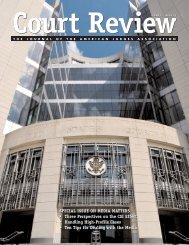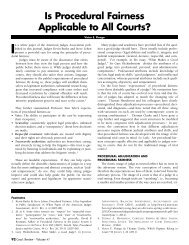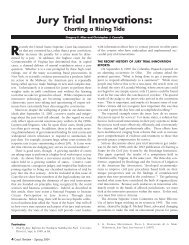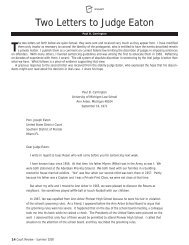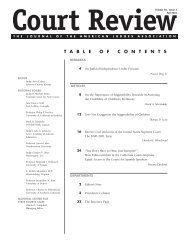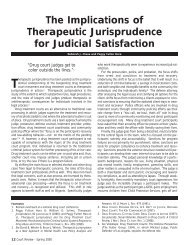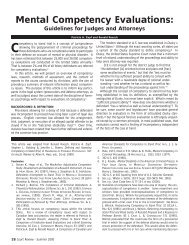Special Issue on Procedural Fairness - American Judges Association
Special Issue on Procedural Fairness - American Judges Association
Special Issue on Procedural Fairness - American Judges Association
- No tags were found...
You also want an ePaper? Increase the reach of your titles
YUMPU automatically turns print PDFs into web optimized ePapers that Google loves.
proposed c<strong>on</strong>diti<strong>on</strong>s, in the judge clearly explaining to theoffender the terms of release, in c<strong>on</strong>ceptualizing probati<strong>on</strong> as atype of bilateral behavioral c<strong>on</strong>tract rather than a unilateraljudicial fiat. 10But the TJ recommendati<strong>on</strong> of having agreed-up<strong>on</strong> familymembers present at the hearing who are aware of the releasec<strong>on</strong>diti<strong>on</strong>s is drawn from an important psychological complianceprinciple that transcends the area of procedural justice. 11So is the recommendati<strong>on</strong> that compliance is enhanced if theoffender is asked to resp<strong>on</strong>d to mild counterarguments aboutthe likelihood of his or her compliance. 12 And so too is therelapse preventi<strong>on</strong> planning recommendati<strong>on</strong> that the offenderbe asked to think about the chain-of-events that led to pastoffending behavior, to ascertain situati<strong>on</strong>s that put the offenderat high-risk, and to suggest how such high-risk situati<strong>on</strong>s canbest be avoided in the future. 13The point, of course, is that procedural fairness takes us agood distance – especially regarding public percepti<strong>on</strong> and satisfacti<strong>on</strong>with the court system – but it needs to be combinedwith TJ if judges are to realize their potential in enhancingcompliance and reducing re-offending. The Canadian TJ judicialmanual does all this and more.B. THE CANADIAN TJ MANUAL AND MOREIn fact, the Canadian manual even adds some meat to theb<strong>on</strong>es of the very core topics of the White Paper. For example,regarding respectful behavior, the TJ manual suggests thatjudges “refer to defendants as ‘sir’ or ma’am, or by title andname (e.g., Mr. Smith; Ms. J<strong>on</strong>es), rather than by first name,the word ‘defendant’, or by case number.” 14 And, in a recommendati<strong>on</strong>clearly relevant to the White Paper’s c<strong>on</strong>cernregarding minority groups and n<strong>on</strong>-native English speakers,the TJ manual urges judges to “pr<strong>on</strong>ounce names correctly;when in doubt, ask court participants for guidance in pr<strong>on</strong>ouncingnames.” 15In discussing needed research, the White Paper notes that“while there is a lot of research at the trial-court level <strong>on</strong> theissue of procedural fairness, there is little research about howthe c<strong>on</strong>cept applies at the appellate level. This could be animportant area for additi<strong>on</strong>al thought and research.” 16Additi<strong>on</strong>al thought and research is indeed needed, but TJhas already made some substantial strides in the appellatearena, including an entire special issue of the Seattle UniversityLaw Review dedicated to it. 17 The Canadian TJ manual alsodevotes some space to the matter, including a suggesti<strong>on</strong> aboutthe importance of appellate courts in their opini<strong>on</strong>s “providingthe appellant with the assurance that his or her story was heardand the salient facts c<strong>on</strong>sidered by the court.” 18 And other TJwriting even takes appellateopini<strong>on</strong>-writing to the level ofrecommendati<strong>on</strong>s for c<strong>on</strong>tinuingjudicial educati<strong>on</strong>.Drawing <strong>on</strong> the implicati<strong>on</strong>s ofNathalie Des Rosiers’ important2000 article in CourtReview, 19 I <strong>on</strong>ce noted that <strong>on</strong>eTJ has alreadymade somesubstantial stridesin the appellatearena...of her TJ proposals is for opini<strong>on</strong>-writing to take the form of a“letter to the loser,” andif past opini<strong>on</strong>s are read through this prism, we arelikely to find admirable, abominable, and averageillustrati<strong>on</strong>s. It may be useful to collect, clarify, anduse these illustrati<strong>on</strong>s in educati<strong>on</strong>al programs forjudges, lawyers, and law students. 20There is also TJ writing regarding the relati<strong>on</strong>ship betweensensitively written appellate opini<strong>on</strong>s and the tricky andnuanced issue of how a defense lawyer might go about explainingan appellate affirmance to a client – and in a way thatshows the client that the lawyer was indeed a vigorous advocatebut that the unsuccessful client has been provided by thecourt with voice and validati<strong>on</strong>. 21C. CRAFTING STATEMENTS OF REASONS INSENTENCINGMostly, of course, both procedural fairness and TJ in thecriminal c<strong>on</strong>text will involve trial level rather than appellatepr<strong>on</strong>ouncements and explorati<strong>on</strong>s. Not surprisingly, therefore,there is also TJ work speaking to the drafting of statementsof reas<strong>on</strong> in the sentencing sphere, and the role of counselin explaining those decisi<strong>on</strong>s and reas<strong>on</strong>s. 22 Even whenimposing incarcerative penalties, judges have been urged toc<strong>on</strong>demn the act rather than the actor and to search for andcomment <strong>on</strong> any offender strengths that might be used asbuilding blocks in shaping a future with hope. 23 Training ofjudges in the drafting of statements of reas<strong>on</strong>s may be especiallyrelevant in jurisdicti<strong>on</strong>s – like some federal circuits 24 —where courts are required to address directly defense sentencingarguments. How rejected defense arguments are resp<strong>on</strong>dedto can, in TJ terms, be either helpful or devastating to defendantsand their resp<strong>on</strong>siveness to rehabilitative efforts. Ifcourts follow the traditi<strong>on</strong>al approach of showing why the governmentshould surely win, why the defense arguments arestretches – in other words, if they write such opini<strong>on</strong>s as c<strong>on</strong>gratulatory“letters to the winner” – the practical results couldbe quite negative. But if they follow the Des Rosers advice ofcrafting a sensitive “letter to the loser” (but always remaining10. Id. at 31.11. Id.12. Id.13. Id.14. JUDGING FOR THE 21ST CENTURY, supra note 3, at 11.15. Id.16. Burke & Leben, supra note 1, at 20.17. 24 SEATTLE U. L. REV. 217 (2000).18. JUDGING FOR THE 21ST CENTURY, supra note 3, at 7.19. Nathalie Des Rosiers, From Telling to Listening: A TherapeuticAnalysis of the Roles of Courts in Minority-Majority C<strong>on</strong>flicts, 37 CT.REV. 54 (2000).20. JUDGING IN A THERAPEUTIC KEY, supra note 3, at 315.21. REHABILITATING LAWYERS, supra note 3, at 39-40.22. Id. at 172-73 & 178-7923. Id. at 172-73. See also Wexler, supra note 1.24. U.S. v. Thomas, 498 F.3d 336 (6th Cir. 2007) (interpreting reas<strong>on</strong>ablenessreview test of Rita v. U.S., 127 S. Ct. 2456 (2007)).Court Review - Volume 44 79



